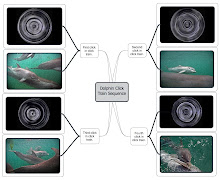A Novel Technique for Decoding Cetacean Language
This breakthrough technique involves making dolphin and whale sounds visible in water, possibly mimicking the very mechanisms that nature evolved in the cetaceans' own sound-receiving apparatus. Using a newly developed instrument, the CymaScope, a team led by Jack Kassewitz in the USA and John Stuart Reid in the UK aim to build a lexicon of cetacean words, each word having a specific meaning and each forming a recognizable pattern, known as a CymaGlyph.
This novel technique is at an early stage of development but there are already signs that it is exactly what researchers have been looking for as a means of exploring cetacean language. Dolphin and whale sounds are complex and conventional sound analyzers (that provide graphical representations) have not proven to be particularly helpful. Instead of providing a graph of a particular cetacean sound, the CymaScope imprints each sound on the surface of water, rather like a fingerprint on glass. Each cetacean sound forms micro disturbances in the surface of the water that can be captured by a digital camera, creating a 'glyph' that may resemble what the dolphin or whale actually sees and recognizes in its audio and visual cortices.





No comments:
Post a Comment